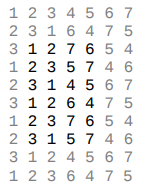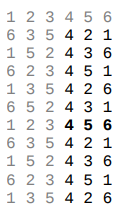COCI '09 Contest 1 #5 Genijalac
View as PDFMirko is a genius. But the purpose of his inventions is not always obvious. His
latest invention, the Shuffle-o-matic 3175, is one of those. The Shuffle-o-matic
is used in a very special way. First Mirko places paper cards, with numbers
to
printed on them, on the Shuffle-o-matic working surface. Then he inputs
the shuffle sequence in the special input console and hits the go button. The
machine then reads the paper cards and outputs the read sequence of
numbers on its output tape. It then shuffles the cards according to the shuffle
sequence. After that it reads the newly obtained sequence and writes it onto a
new line on its output tape. Then it proceeds to shuffle the cards again
according to the same shuffle sequence, scans and writes the output to the
tape. The machine does this until it runs out of tape.
After experimenting with the machine Mirko decided to rest a bit on the floor.
There he noticed a piece of output tape. The piece is neatly cut just before the
-th output row and just after the
-th output row. It is also missing the first
number and the last
numbers in all rows.
He now wonders how many rows on that piece of paper have the property that all numbers in the row, that are still on the paper, are in the exact same spot they were before all the shuffling began.
Input Specification
The first line of input contains integers and
in that order
.
The second line contains the shuffle sequence. The sequence is given as a
permutation of numbers to
. If the
-th number in the shuffle sequence is
,
after each shuffle the
-th element in the resulting sequence is the
-th
element in the previous sequence.
Output Specification
In the first and only line of input print the number of rows that have the property Mirko is looking for.
Scoring
Test cases worth total points have
.
Sample Input 1
4 1 5 0 1
1 3 4 2Sample Output 1
2Explanation for Sample Output 1
Shuffle-o-matic outputs:

Mirko finds:

The first and fourth rows are interesting to Mirko.
Sample Input 2
7 3 8 1 2
2 3 1 6 4 7 5Sample Output 2
0Explanation for Sample Output 2
Shuffle-o-matic outputs:

Sample Input 3
6 2 11 3 0
6 3 5 4 2 1Sample Output 3
1Explanation for Sample Output 3
Shuffle-o-matic outputs:

Comments